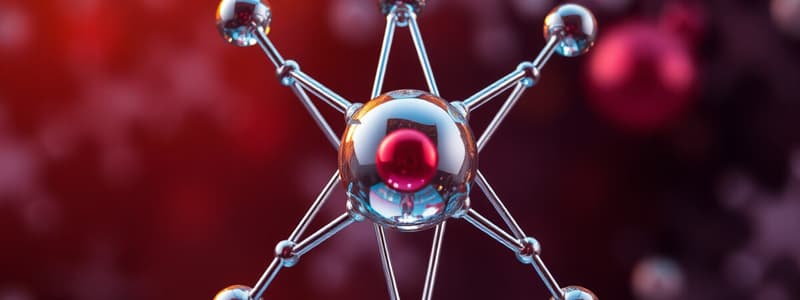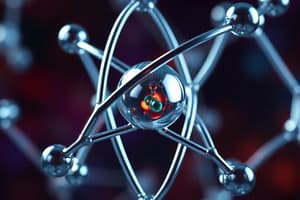Podcast
Questions and Answers
Which of the following subatomic particles has a positive charge?
Which of the following subatomic particles has a positive charge?
- Neutron
- Proton (correct)
- Electron
- All of the above
The number of neutrons in an atom determines its atomic number.
The number of neutrons in an atom determines its atomic number.
False (B)
What type of bond forms between two nonmetals where they share electrons?
What type of bond forms between two nonmetals where they share electrons?
Covalent bond
The state of matter that has a fixed volume but takes the shape of its container is called a ______.
The state of matter that has a fixed volume but takes the shape of its container is called a ______.
Match the following types of chemical reactions with their descriptions:
Match the following types of chemical reactions with their descriptions:
What is the name for the vertical columns in the periodic table?
What is the name for the vertical columns in the periodic table?
Metals are typically good conductors of heat and electricity.
Metals are typically good conductors of heat and electricity.
What is the pH range for acidic solutions?
What is the pH range for acidic solutions?
A chemical reaction that releases heat to the surroundings is called an ______ reaction.
A chemical reaction that releases heat to the surroundings is called an ______ reaction.
Match each term with its corresponding definition.
Match each term with its corresponding definition.
Which of the following is NOT a unit of concentration?
Which of the following is NOT a unit of concentration?
Weak acids and bases fully ionize in solution.
Weak acids and bases fully ionize in solution.
What are the products formed in a neutralization reaction between an acid and a base?
What are the products formed in a neutralization reaction between an acid and a base?
Flashcards
Atom
Atom
The fundamental building block of matter, consisting of a nucleus surrounded by electrons.
Proton
Proton
A positively charged particle found in the nucleus of an atom.
Neutron
Neutron
A particle found in the nucleus of an atom with no charge.
Isotope
Isotope
Signup and view all the flashcards
Ionic Bond
Ionic Bond
Signup and view all the flashcards
Covalent Bond
Covalent Bond
Signup and view all the flashcards
States of Matter
States of Matter
Signup and view all the flashcards
Chemical Reaction
Chemical Reaction
Signup and view all the flashcards
Periodic Table Groups
Periodic Table Groups
Signup and view all the flashcards
Periodic Table Periods
Periodic Table Periods
Signup and view all the flashcards
Acids
Acids
Signup and view all the flashcards
Bases
Bases
Signup and view all the flashcards
pH Scale
pH Scale
Signup and view all the flashcards
Stoichiometry
Stoichiometry
Signup and view all the flashcards
Solutions
Solutions
Signup and view all the flashcards
Thermochemistry
Thermochemistry
Signup and view all the flashcards
Study Notes
Atomic Structure
- Atoms are the fundamental building blocks of matter.
- Atoms consist of a nucleus containing protons and neutrons, surrounded by electrons orbiting the nucleus.
- Protons have a positive charge, electrons have a negative charge, and neutrons have no charge.
- The number of protons in an atom's nucleus determines its atomic number and defines the element.
- The atomic mass of an atom is approximately equal to the sum of protons and neutrons.
- Isotopes are atoms of the same element with different numbers of neutrons.
- Electron configuration describes the arrangement of electrons in different energy levels and orbitals around the nucleus.
Bonding
- Chemical bonds hold atoms together to form molecules and compounds.
- Ionic bonds form between metals and nonmetals, where one atom loses electrons (forming a positive ion) and another gains electrons (forming a negative ion). Electrostatic forces then attract the oppositely charged ions.
- Covalent bonds form between nonmetals, where atoms share electrons.
- Metallic bonds form between metal atoms, where electrons are delocalized and shared among many atoms.
- Polar covalent bonds occur when atoms share electrons unequally, leading to a partial positive and partial negative charge on different parts of the molecule.
States of Matter
- Matter exists in three primary states: solid, liquid, and gas.
- Solids have a fixed shape and volume.
- Liquids have a fixed volume but take the shape of their container.
- Gases have neither a fixed shape nor a fixed volume, and expand to fill their container.
- Changes in temperature and pressure can affect the state of matter.
Chemical Reactions
- Chemical reactions involve the rearrangement of atoms to form new substances.
- Reactants are the substances that undergo change, and products are the substances formed from the reaction.
- Balancing chemical equations ensures that the number of atoms of each element is the same on both sides of the equation.
- Chemical reactions can be classified into different types, including synthesis, decomposition, single displacement, double displacement, and combustion.
- Chemical reactions involve the breaking and forming of chemical bonds.
- The rate of a chemical reaction can be affected by factors such as temperature, concentration, surface area, and catalysts.
Periodic Table
- The periodic table organizes elements by their atomic number and properties.
- Elements with similar properties are grouped together in columns called groups or families.
- Elements are arranged in rows called periods.
- The periodic table provides information about the atomic structure, electron configuration, and reactivity of each element.
- Elements are classified as metals, nonmetals, and metalloids based on their properties. Metals are typically good conductors of heat and electricity, nonmetals are generally poor conductors, and metalloids exhibit properties of both.
Acids and Bases
- Acids donate protons (H+) in a solution.
- Bases accept protons (H+) in a solution.
- The pH scale measures the acidity or basicity of a solution.
- A pH of 7 is neutral.
- A pH below 7 is acidic.
- A pH above 7 is basic.
- Strong acids and bases fully ionize in solution.
- Weak acids and bases partially ionize in solution.
- Acids and bases react to form salts and water in neutralization reactions.
Stoichiometry
- Stoichiometry is the quantitative relationship between reactants and products in a chemical reaction.
- Mole ratios are used to determine the amounts of reactants and products involved.
- Calculations using moles, molar mass, and volume of gases are fundamental to stoichiometric analysis.
Solutions
- Solutions are homogeneous mixtures of two or more substances.
- The solvent is the substance that dissolves the solute.
- Concentration is a measure of the amount of solute in a given amount of solvent or solution.
- Different concentration units, such as molarity, molality, and percentage, are used to express the concentration of solutes.
- Solubility describes the maximum amount of solute that can dissolve in a given amount of solvent at a specific temperature and pressure.
Thermochemistry
- Thermochemistry deals with the heat transfer associated with chemical reactions.
- Exothermic reactions release heat to the surroundings.
- Endothermic reactions absorb heat from the surroundings.
- Enthalpy is a measure of the heat content of a system.
- Enthalpy change (∆H) describes the heat absorbed or released during a reaction under constant pressure.
Studying That Suits You
Use AI to generate personalized quizzes and flashcards to suit your learning preferences.




